Problem 1. Why do economic and accounting profits usually differ?
a. Because accounting profit includes only explicit costs.
b. Because opportunity costs are not included in calculating accounting profits.
c. Because accounting profits are calculated by accountants while economic profits are calculated by economists.
d. (a) and (b)
Use the graph below to answer the next question.
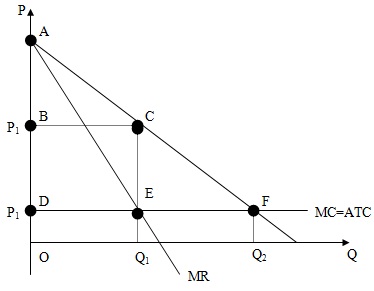
Problem 2. From the information in the above figure we can say that:
a. Monopoly revenues are given by the area BCQ1O.
b. The deadweight loss in this market is given by the area CEF.
c. The total profit for this monopolist is given by the area BCED.
d. All of the above.
Problem 3. A big American company decides to go international and open a manufacturing unit in Europe. The company hires an economist to analyze whether that would actually be a good decision. The economist reports the following finding: “Even though the manufacturing unit is identical to the one in the US it will not be able to produce the same amount of output due to some environmental pollution restrictions.” This means that if this unit is actually opened the company will exhibit some:
a. Increasing returns to scale.
b. Decreasing returns to scale.
c. Constant returns to scale.
d. Economies of scale.
Use the picture below to answer the next three questions.
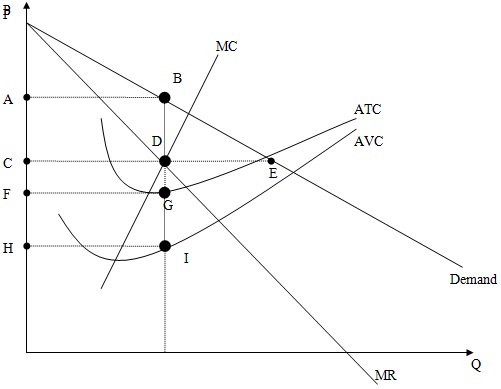
Problem 4. What is the price that the monopolist will charge in order to maximize its profit.
a. Price=A
b. Price=C
c. Price=F
d. Price=H
Problem 5. Consider a monopolist facing the costs and the demand curve in the above graph. The maximum profit this monopolist can earn is equal to the area:
a. ABDC
b. CDGF
c. ABGF
d. ABIH
Problem 6. Fixed costs for the above monopolist are given by the area:
a. ABDC
b. ABEC
c. FGIH
d. CDIH
Use this graph to answer the following questions. Presently, the market price is $45 and the market is perfectly competitive.
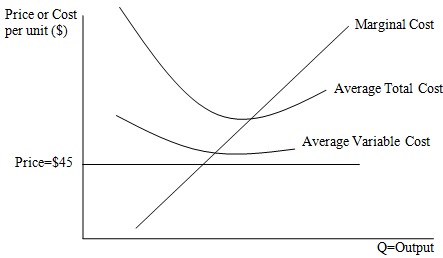
Problem 7. Which of the following best describes the above firm in the short run, if the firm is producing at the profit maximizing point?
a. The firm is making a positive economic profit.
b. The firm is making a negative economic profit when it produces the profit maximizing output.
c. The firm will choose to shut down.
d. The firm is breaking even when it produces the profit maximizing output since all perfectly competitive firms break-even.
Problem 8. The apple market in the Vegetable Kingdom is perfectly competitive. Currently, the price of apples is $50 and all firms are producing at the profit maximizing quantity of 10 units. Thus, we can say that marginal cost for each firm is
a. $50.
b. $500.
c. $5.
d. $10.
Problem 9. What is the minimum-cost output? The quantity of output at which
a. Total cost is lowest.
b. Average total cost is lowest.
c. Average variable cost is lowest.
d. Marginal cost is lowest.
Please use the following table to answer the next two questions. The cost schedule below is for firm ABC, which produces boots.
Pair of Boots Average Total Cost Total Cost
0 0 10
1 20 20
2 12.5 25
3 8.66 26
4 7.75 31
5 8.2 41
Problem 10. Which of the below figures best represents the marginal cost for firm ABC? (On the horizontal axis we have the level of production and on the vertical axis the marginal cost)
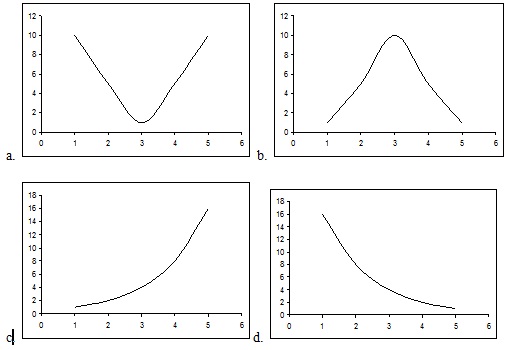
Problem 11. If firm ABC produces 4 pairs of boots, which of the following is true? The
a. Average variable cost is $21.
b. Average fixed cost is $2.5.
c. Marginal cost is $1.
d. None of the above.
Problem 12. The maximum amount of total product that any particular collection of inputs is capable of producing during a particular time period is described by:
a. The marginal product.
b. The average cost.
c. The producer surplus.
d. The production function.
Problem 13. In the long run when the quantity of output increases and the average total costs decrease, we say that a firm experiences
a. Economies of scale.
b. Diseconomies of scale.
c. Diminishing marginal returns.
d. Increasing average fixed costs.
Problem 14. If a natural monopoly is regulated and forced to set a price equal to marginal cost, then the output chosen by the monopoly will be
a. Equal to the level of output a profit maximizing monopoly would produce.
b. Equal to the level of output the market would produce if it was a perfectly competitive market.
c. Less than the perfectly competitive level of output and more than the profit maximizing level of output for the monopolist.
d. Greater than the perfectly competitive level of output.
Problem 15. Consider South’s orange farm. If he increases orange production from 99 to 100 bags of oranges, his average total cost will rise from $1 to $1.1. What is the marginal cost of the 100th unit of output?
a. $0.1
b. $10
c. $11
d. $110
Problem 16. Suppose the market for bananas is perfectly competitive and the market price of bananas is $10. At this price, the profit maximizing quantity is 50. When the quantity is 50, the average total cost is $5 per banana. Which of the following statements is true?
a. There is a negative economic profit of $250.
b. There is a positive economic profit of $250.
c. There is a negative economic profit of $500.
d. There is a positive economic profit of $500.
Problem 17. Which of the following statements is true if fixed costs are positive?
a. The marginal cost curve crosses the average fixed cost curve at the lowest point on the average fixed cost curve.
b. Average variable cost equals quantity times total variable costs.
c. Average total costs equal the sum of the average fixed costs and marginal costs.
d. Average variable costs are less than average total costs.
Use the picture below to answer the next two questions.
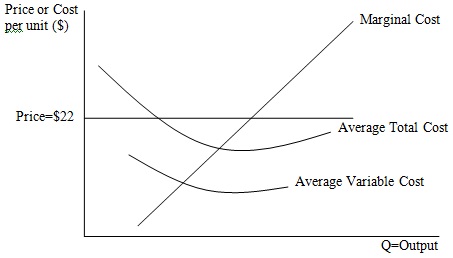
Problem 18. Among the following labels, what is the appropriate label to describe the situation described in the above figure? Note: Presently, the market price is $22 and the market is perfectly competitive.
a. Shut down
b. Negative economic profit
c. Break-even
d. Positive economic profit
Problem 19. Based on the above graph, which of the following statements about the long run is true?
a. More firms will enter this industry, which will lead to an increase in the market supply and a fall in the equilibrium price.
b. More firms will enter this industry, which will eventually lead to a rise in the equilibrium price.
c. Some firms will exit this industry leading to a decrease in the market supply and a rise in the equilibrium price
d. Some firms will exit this industry, which will eventually lead to a fall in the equilibrium price.
Problem 20. Sometimes, even if the company incurs a “Loss,” they should continue to produce goods at the profit maximizing quantity because
a. In the model studied in the lecture, we assume that some companies are very stupid.
b. They can still cover some of their fixed costs.
c. They can still earn positive economic profits given the above scenario.
d. The above statement is wrong. They should always stop producing goods if they are incurring a loss.
Use the following information to answer the next three questions.
Consider a perfectly competitive market where each firm has MC=Q. The market demand function is Q=10,000-P. The market supply curve is Q = 99P.
Problem 21. What is equilibrium price on this market?
a. $100
b. $99
c. $50
d. $10
Problem 22. What is the equilibrium quantity produced on this market?
a. 9900
b. 3300
c. 100
d. 20
Problem 23. How many firms are currently producing on this market?
a. 100
b. 99
c. 50
d. 9900
Problem 24. If a natural monopoly is not regulated, then what quantity will it choose to produce in the market?
a. The quantity where marginal cost intersects the average variable cost curve.
b. The quantity where the average total cost curve attains a minimum.
c. The quantity where marginal revenue is equal to marginal cost.
d. The quantity where the marginal cost curve attains a minimum.
Below is a table that lists the average total costs (ATC) for four firms that produce cardboard boxes. Assume that the size of the market is never more than a quantity of 80 units.
Firm A Firm B Firm C Firm D
Quantity ATC ATC ATC ATC
10 10 20 15 25
20 9 18 14 20
30 8 16 13 15
40 7 15 12 10
50 6 14 11 15
60 7 12 10 20
70 8 11 9 30
80 10 10 11 35
Problem 25. According to the table above, which of the following firms is most likely to be a natural monopolist?
a. Firm A
b. Firm B
c. Firm C
d. Firm D
Problem 26. Which of the following is the best example of a natural monopoly?
a. Company V, which is the only producer of supercomputers in the world.
b. Company X, which owns plenty of a necessary input for production.
c. Company Y, that provides Gas and Electric service in a small city.
d. Company Z, a long-distance telephone service.
Problem 27. If a natural monopoly is forced to use average total cost pricing (set its price equal to its average total cost for the quantity it produces), then which of the following will occur?
a. The firm will make zero economic profits.
b. The firm will shut down.
c. The firm will make negative economic profits, but decide to continue to operate in the short run.
d. The firm will make positive economic profits.
Use the information below to answer the following question:
Suppose the firm represented in the table below produces apples using land and labor. The following is a table with information about the operation of the firm during the last six months:
|
Month
|
Month 1
|
Month 2
|
Month 3
|
Month 4
|
Month 5
|
Month 6
|
|
Land
|
1
|
1
|
1
|
1
|
1
|
1
|
|
Labor
|
1
|
4
|
9
|
16
|
25
|
36
|
|
Total production
|
1
|
2
|
3
|
4
|
5
|
6
|
Problem 28. According to the information above, which of the following statements is true?
a. For the six months under consideration, the variable input is labor and the fixed input is land.
b. The firm was operating in the short run during the last six months.
c. The law of diminishing returns has held for this firm during the last six months.
d. All of the above are true statements.
Use the following information to answer the next two questions.
For a single-price monopolist, the demand curve is given by P=100-5Q and marginal revenue curve by MR=100-10Q. The marginal cost for this monopolist is MC=10Q.
Problem 29. What is the profit maximizing quantity and price chosen by the monopolist?
a. 5, $75
b. 5, $50
c. 10, $50
d. 10, $10
Problem 30. If a perfectly competitive industry turns into a monopoly, then Consumer’s Surplus will
a. Increase.
b. Decrease.
c. Would not change.
d. Could increase, decrease, or remain unchanged.